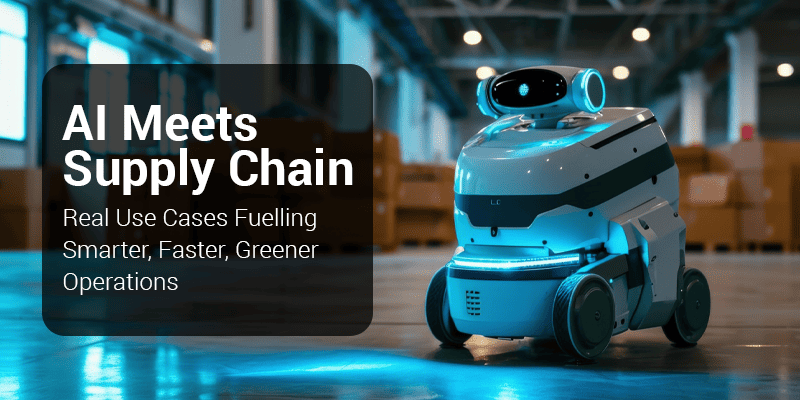AI Meets Supply Chain – Real Use Cases Fuelling Smarter, Faster, Greener Operations

Supply chain analytics combined with artificial intelligence (AI) is no longer a futuristic concept but a present-day reality reshaping industries worldwide. Moving beyond generic benefits, let’s explore concrete use cases and industry examples that illustrate how AI-driven analytics is transforming supply chains into agile, efficient, and sustainable systems.
AI-Powered Automation in Supply Chains
One of the most tangible impacts of AI is in automating routine and repetitive tasks. For example, back-office automation uses AI technologies for robotic process automation (RPA) and conversational AI to handle invoice processing, purchase order management, and data entry. This reduces manual errors and frees supply chain professionals to focus on strategic activities such as supplier negotiations and demand planning[1].
In warehousing, AI-powered robots and automated systems perform picking, sorting, and packaging tasks around the clock. Amazon’s Sequoia Robotics system[2], for instance, has increased inventory identification and storage speed by 75%, reduced human effort by 15%, and cut processing time by 25%. This kind of automation supports resilience during labour shortages and demand surges.
Logistics Optimisation with AI
AI excels at optimising logistics by processing real-time data to enhance routing and delivery. UPS’s ORION system is a prime example: it uses AI algorithms to calculate the most efficient delivery routes, saving the company up to 100 million miles annually. This reduces fuel consumption, lowers carbon emissions, and speeds up deliveries[3].
Similarly, Amazon’s AI-driven logistics network forecasts demand for millions of items daily, dynamically restocking warehouses close to predicted demand zones. During Cyber Monday 2023, AI predicted demand for over 400 million items, enabling Amazon to optimise inventory placement and reduce delivery times significantly.
Demand Forecasting and Bullwhip Effect Mitigation
Demand forecasting is a critical supply chain function improved dramatically by AI. By analysing sales data, social media trends, weather patterns, and economic indicators, AI models generate highly accurate, region-specific forecasts.
For instance, Zara leverages AI-powered demand sensing to monitor fashion trends and social media buzz, enabling rapid restocking of bestsellers and reducing overproduction. This agility helps Zara minimise waste and maximise revenue from fast-moving products.
AI also helps mitigate the notorious bullwhip effect, where small fluctuations in customer demand cause large upstream supply chain disruptions. By improving real-time data sharing and predictive analytics, AI enables better coordination among supply chain partners, smoothing demand variability.
Supplier Relationship and Risk Management
AI enhances supplier management by evaluating supplier performance through data analytics, including delivery history, quality scores, and compliance records. This insight helps companies identify risks early and negotiate better terms.
For example, Tata Steel uses AI to monitor supplier performance and optimise logistics, ensuring timely raw material availability and reducing downtime[4]. AI also simulates risk scenarios such as natural disasters or geopolitical events, helping companies build contingency plans.
Sustainability Through AI
Sustainability is a growing priority, and AI supports greener supply chains. Amazon’s Packaging Decision Engine (PDE) uses AI to optimise packaging size and materials, eliminating over 2 million tons of packaging waste globally since 2015.
AI also enables carbon accounting and emissions tracking by analysing energy usage, transportation data, and material sourcing to estimate and reduce carbon footprints. This helps companies comply with regulations and develop cost-effective carbon management strategies[4].
Conclusion
From Amazon’s AI-driven demand forecasting and warehouse robotics to UPS’s AI-optimised delivery routes and Zara’s trend-responsive inventory management, AI-powered supply chain analytics is driving unprecedented efficiency, resilience, and sustainability. These real-world examples showcase how AI transforms data into actionable intelligence, enabling businesses to anticipate disruptions, optimise operations, and meet evolving customer expectations in a dynamic global market.
The future belongs to those who harness AI not just as a tool but as a strategic partner in supply chain innovation. The question is—how will you shape the future of AI? At REVA Academy for Corporate Excellence (RACE), REVA University, our specialised research groups are actively developing cutting-edge AI projects in collaboration with leading organisations. Explore our bespoke programs in Artificial Intelligence to deepen your expertise and stay ahead in this rapidly evolving field. Join our vibrant research community and take the next step in building your AI capabilities to drive innovation and transform industries.
Visit our website race. reva.edu.in or Call: +91 89040 58866 or write to us: race@reva.edu.in
References:
- Times of India, “This is how Amazon is using AI-powered robots to reduce delivery time,” detailing Amazon’s Sequoia robotics system improving warehouse efficiency and safety, 2023
- Nightview Capital, “How Amazon Robotics Is Transforming Its Long-term Profit Engine,” describing AI-driven workflow orchestration and inventory optimization in Amazon warehouses, 2025
- SIBM Bengaluru, “Adoption of next generation robotics: A case study on Amazon,” covering Kiva robots and automation impact on warehouse operations, 2017
- About Amazon, “Amazon announces new fulfillment center robots, Sequoia and Digit,” explaining the collaboration between humans and robots to enhance safety and speed, 2023
- Pyrops, “Is Amazon Automation Revolutionizing Supply Chain Management?,” highlighting Sequoia and Digit robots and human-robot collaboration, 2024
- Exotec, “How Amazon Robotics Has Changed the Landscape of Fulfillment,” discussing Amazon’s robotics history, innovations like Sparrow, and their impact on efficiency and ergonomics, 2025
- In Practice, “Amazon Robotics & The Rise of Warehouse Automation,” providing insights into Amazon’s proprietary warehouse control systems and remote automation, 2025
- Seeking Alpha, “Automating The Warehouse: Insights From Amazon’s Robotics Efforts,” emphasizing productivity gains from extensive warehouse robot deployment, 2024
- TechEblog, “Amazon’s Robotic Revolution is Now a Million Machines,” describing the scale and sophistication of Amazon’s robotic warehouse operations, 2023.
- https://research.aimultiple.com/supply-chain-ai/
- https://cdotimes.com/2024/08/23/case-study-amazons-ai-driven-supply-chain-a-blueprint-for-the-future-of-global-logistics/
- https://www.ccoconsulting.com/ai-in-supply-chain-management-optimization-case-studies/
- https://cleartax.in/s/ai-in-supply-chain
AUTHORS



